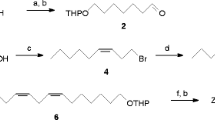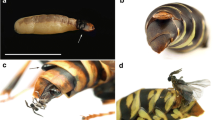Abstract
Homologs of bombykal, (10E,12Z)-10,12-hexadecadienal, have been reported to be sex pheromones or sexual attractants of several species of sphingid moths. In this study, we identified novel bombykal analogs as sex pheromone components from a Japanese sphingid moth, Dolbina tancrei. Staudinger (Sphingidae: Lepidoptera). Sex pheromone gland extracts from calling female moths were subjected to gas chromatography/electroantennograhic detection (GC/EAD), gas chromatography/mass spectrometry (GC/MS), and gas chromatography (GC) analyses. GC/EAD analyses showed two active components in the crude pheromone extracts. GC/MS analysis determined these two components to be pentadecadienals. GC/MS of their MTAD derivatives showed conjugated double bonds at the 9- and 11-positions, indicating 9,11-pentadecadienals. The isomeric configurations of these candidates were determined by comparison of their Kováts retention indices with those of synthetic compounds. Field bioassays with the four isomers of 9,11-pentadecadienal and their mixtures confirmed that the two sex pheromone components of D. tancrei are (9E,11Z)-9,11-pentadecadienal and (9Z,11Z)-9,11-pentadecadienal, with the highest male catches observed for a 90:10 blend. This is the first report of 9,11-pentadecadienals as sex pheromone components in lepidopteran species.





Similar content being viewed by others
References
Ando T, Yamakawa R (2011) Analyses of lepidopteran sex pheromones by mass spectrometry. Trends Anal Chem 30:990–1002
Ando T, Yoshida S, Tatsuki S, Takahashi N (1977) Sex attractants for male Lepidoptera. Agric Biol Chem 48:1485–1492
Ando T, Kurotsu Y, Kaiya M, Utiyama M (1985) Systematic syntheses and characterization of dodecadien-1-ols with conjugated double bond, lepidopterous sex pheromones. Agric Biol Chem 49:141–148
Ando T, Ogura Y, Uchiyama M (1988) Mass spectra of lepidopterous sex pheromones with a conjugated diene system. Agric Biol Chem 52:1415–1423
Ando T, Inomata S, Yamamoto M (2004) Lepidopteran sex pheromones. Top Curr Chem 239:51–96
Anonymous (2006) Major insect and other pests of economic plants in Japan. The Japanese Society of Applied Entomology and Zoology, Tokyo, 387pp. (in Japanese)
Bestmann HJ, Erler J, Garbe W, Kern F, Martischonok V, Schäfer D, Vostrowsky O, Wasserthal LT (1992) Pheromone components of the female elephant hawk-moth, Deilephila elpenor, and the silver-striped hawk-moth, Hippotion celerio. Experientia 48:610–613
Do ND, Kinjo M, Taguri T, Adachi Y, Yamakawa R, Ando T (2009) Synthesis and field evaluation of methyl-branched ketones, sex pheromone components produced by Lithosiinae female moths in the family of Arctiidae. Biosci Biotechnol Biochem 73:1618–1622
Do ND, Ohbayashi K, Naka H, Nakada K, Ando T (2011) Identification and field evaluation of se pheromone components of the pear barkminer moth, Spulerina astaurota. J Chem Ecol 37:1222–1230
El-Sayed AM (2011) The pherobase. http://www.pherobase.com/
Kawahara AY, Mignault AA, Regier JC, Kitching IJ, Mitter C (2009) Phylogeny and biogeography of hawkmoths (Lepidoptera: Sphingidae): evidence 25. from five nuclear genes. PLoS ONE 4:e5719
Landolt PJ, Tumlinson JH, Brennan MM (1989) Attraction of Amphion floridensis (Lepidoptera: Sphingidae) to bombykal, (E, Z)-10,12-hexadecadienal. Fla Entomol 72:324–327
McDonough LM, Averill AL, Davis HG, Smithhisler CL, Murray DA, Chapman PS, Voerman S, Dapsis LJ, Averill MM (1994) Sex pheromone of cranberry fruitworm, Acrobasis vaccinii riley (Lepidoptera: Pyralidae). J Chem Ecol 20:3269–3279
Millar JG, Knudson AE, McElfresh JS, Gries R, Gries G, Davis JH (1996) Sex attractant pheromone of the pecan nut casebearer (Lepidoptera: Pyralidae). Bioorg Med Chem 4:331–339
Nash BW, Thomas DA, Warburton WK, Williams TD (1965) The preparation of capillin and some related compounds, and of some substituted pent-4-en-2-yn-1-ones. J Chem Soc 2983–2989
Nesbitt BF, Beevor PS, Cork A, Hall DR, David H, Nandagopal V (1986) The female sex pheromone of sugarcane stalk borer, Chilo auricilius. Identification of four components and field tests. J Chem Ecol 12:1377–1388
Nishida T, Vang LV, Yamazawa H, Yoshida R, Naka H, Tsuchida K, Ando T (2003) Synthesis and characterization of hexadecadienyl compounds with a conjugated diene system, sex pheromone of the persimmon fruit moth and related compounds. Biosci Biotechnol Biochem 67:822–829
Reed DW, Underhill EW, Giblin EM (1987) Attraction of sphingid moths (Lepidoptera: Sphingidae) to 10,12-hexadecadienyl aldehydes and acetates: evidence of pheromone components. J Chem Ecol 13:931–942
Sarzynski EM, Liburd OE (2004) Effect of trap height and within-planting location on captures of cranberry fruitworm (Lepidoptera: Pyralidae) in highbush blueberries. Agric For Entomol 6:199–204
Starratt AN, Dahm KH, Allen N, Hildebrand JG, Payne TL, Röller H (1979) Bombykal, a sex pheromone of the sphinx moth Manduca sexta. Z Naturforsch C 34:9–12
Tabata J, Minamishima M, Sugie H, Fukumoto T, Mochizuki F, Yoshiyasu Y (2009) Sex pheromone components of the pear fruit moth, Acrobasis pyrivorella (Matsumura). J Chem Ecol 35:243–249
Tumlinson JH, Mitchell ER, Doolittle RE, Jackson DM (1994) Field tests of synthetic Manduca sexta sex pheromone. J Chem Ecol 20:579–591
Uehara T, Naka H, Matsuyama S, Ando T, Honda H (2012) Identification and field evaluation of sex pheromones in two hawk moths Deilephila elpenor lewisii and Theretra oldenlandiae (Lepidoptera; Sphingidae). Appl Entomol Zool 47:227–232
Wakamura S, Yasuda T, Watanabe M, Kiguchi K, Shimoda M, Ando T (1996) Sex pheromone of the sweetpotato hornworm, Agrius convolvuli (L.) (Lepidoptera: Sphingidae): identification of a major component and its activity in a wind tunnel. Appl Entomol Zool 31:171–174
Young DC, Vouros P, Holick MF (1990) Gas chromatography–mass spectrometry of conjugated dienes by derivatization with 4-methyl-1,2,4-triazoline-3,5-dione. J Chromatogr 522:295–302
Acknowledgments
We thank Dr. DeMar Taylor for his critical reading of the manuscript and Mr. Takahiro Yano for important information on D. tancrei. We are also grateful to Ms. Kanako Ohbayashi and students of the Laboratory of Applied Entomology in Tottori University for their help with insect collection and rearing.
Author information
Authors and Affiliations
Corresponding author
Rights and permissions
About this article
Cite this article
Uehara, T., Naka, H., Matsuyama, S. et al. Identification of Conjugated Pentadecadienals as Sex Pheromone Components of the Sphingid Moth, Dolbina tancrei . J Chem Ecol 39, 1441–1447 (2013). https://doi.org/10.1007/s10886-013-0357-1
Received:
Revised:
Accepted:
Published:
Issue Date:
DOI: https://doi.org/10.1007/s10886-013-0357-1




